I was delighted with the friendly reception I received and the facilities at the Loikaw Lodge. I slept well in their large, soft bed and enjoyed a filling, English breakfast.
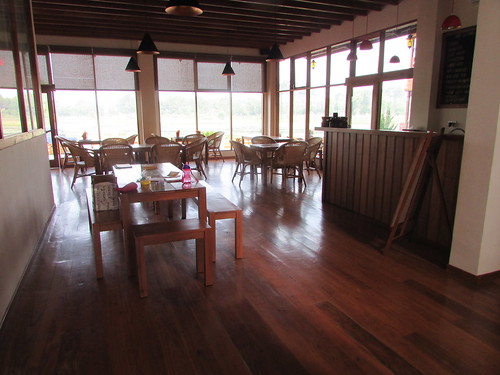
Loikaw Lodge: The Dining Room.
At 8.30 a.m., I was picked up by my guide and driver and we made our way to Loikaw Market. The market was large with both outside stalls (often provided with sun shades of various types) and an extensive, gloomy covered market. Everything you can imagine is available in these markets - vegetables (familiar and exotic), spices, fresh and dried fish, chicken, beef.
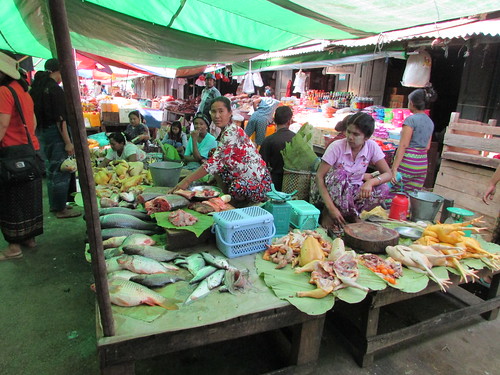
Loikaw Market.
Many of the stallholders were wielding serious-looking knives which they used to prepare their wares. The inside market was mainly dry goods of all kinds - clothing, toiletries (including make-up and shampoo), luggage, backpacks, ladies fashion handbags, sturdy shopping bags. A seamstress with a treadle sewing machine offered alteration and a watchmaker offered repairs. There was also a large hardware stall selling a bewildering array of items, including loose nails in various sizes. At one stall, a lady was expertly using four frying pans at once to prepare thick pancakes while you wait.

Loikaw Market: Making four pancakes at once
Next, we visited Loikaw Railway Station. The station had and impressive reinforced concrete two-storey building with steel-framed overall roof, appropriate to a State Capital. Footbridges were provided at each end of the station - somewhat unnecessarily as gaps were deliberately provided in the concrete-post and barbed wire fence between the tracks alllowing everybody to cross at ground level. The station has just one departure a day at 05:00 which takes ten hours to reach Kalaw and this service returns in the evening at 21:45. The Ordinary Class single fare is 1,500 Kyat, The Upper Class fare 2,000 Kyat.
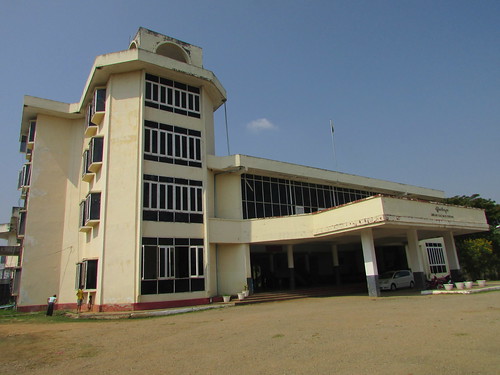
Loikaw Station: This impressive station building handles just a morning departure and an evening arrival.
Our next visit was to the Poa Pa Yone monastery where there were 311 novices and 43 monks (although a number of monks were absent on the day of our visit). We stayed to watch the novices summoned to lunch which they ate in a large dining room with round, low tables. Monks have only two meals a day - breakfast and lunch. We also visited the monastery kitchen where the monks' food is prepared.
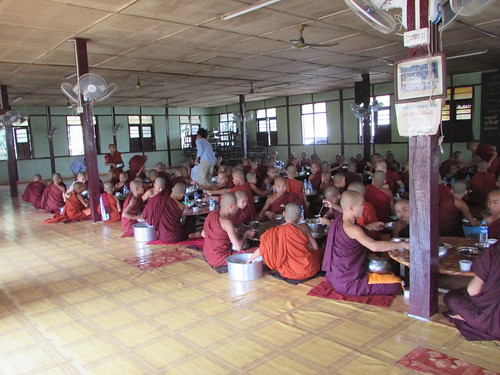
Loikaw Monastery: Novices taking lunch.
Our car then took us to a weaving factory where fabrics in the various traditional designs are produced. One wooden hand loom was in use and it was remarkable how quickly fabric can be produced in this way. There were also two fairly elderly motorised machines. The one was used to load the small bobbins with thread. The bobbin is carried inside the shuttle which performs the actual weaving as it oscillated across the weaving frame. The other machine was a power loom which was certainly quicker than the hand loom, but much noisier.

Loikaw: Hand loom in use.
Near the weaving factory, I looked at a rather rickety wooden road bridge which seemed to carry a lot of traffic. From the bridge, I had a good view of daily life along the river bank. I could also see numerous tiny pump-houses drawing up the brown river water with electric pumps and delivering it through exposed blue plastic pipes to various premises. Adjacent to the bridge was a tall wooden tower which appeared to be a public water supply. I presumed that a larger electric pump was drawing river water into a storage tank at the top of the tower, from which various discharge pipes could service water tankers to distribute the water. A large road tanker noisily moved away having filled-up and it was soon replaced by one of the smaller rather primitive-looking lorries powered by a noisy Chinese diesel engine, where the load space was completely occupied by a large, rectangular water tank.
The Loikaw Cultural Museum formed our next destination. This was another reinforced concrete structure in 'municipal' style but freshly-painted and with immaculate gardens. In Kayah State, nine different ethnic sub-groups are recognised and the museum featured the distinctive clothing used by each tribe. There's a little more about Kayah State and its ethicities in the Wikipedia article here and about the 135 ethnic groups recognised in Myanmar in the Wikipedia article here. I spent some time studying the interesting exhibits. In the 'Show Room of Kayah State Historical Record and Kayah Chief, I was particularly intrigued by a photograph of the ceremony erecting a tall wooden post which I learned was called a Kutopoe Pillar.
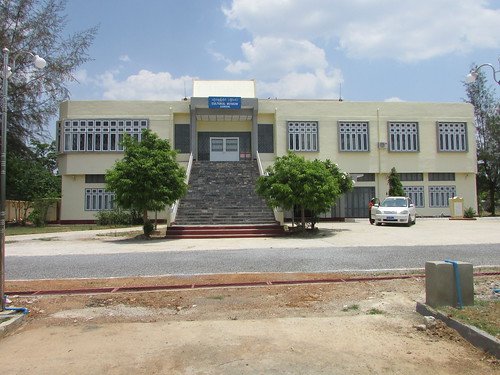
Loikaw Cultural Museum
After lunch at a typical teashop, I was taken to the site where many white-painted Kutopoe pillars have been erected. I'd seen plenty of evidence of Buddhism and Christianity in Kayah State but Animism also exists and the Kutopoe Pillars form part of the Animist tradition.
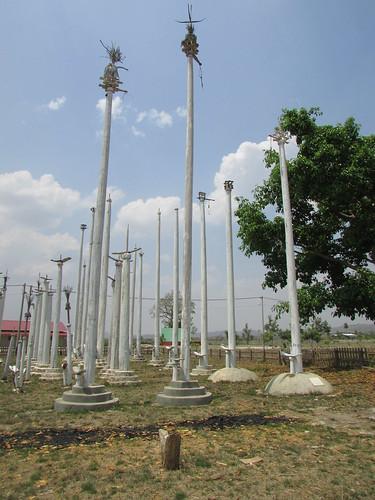
Kutopoe Pillars.
Then it was back to the hotel for a rest before setting off again at 4.30 p.m. to see one of the most famous features in Loikaw - Taung Gwe Zedi. Near the centre of Loikaw, a rocky outcrop rears out of the plain, fractured and fissured leaving a number of pinnacles. In this unlikely location, a series of increasingly improbable pagodas have been erected, accessible from the ground by a number of twisting stairs, forming Taung Gwe Zedi. Some of the pagodas overhang the rock, cantilevered into space on concrete 'rafts' and the various pinnacles are interconnected by a bewildering series of bridges and stairways. A modern elevator (lift) provides easy and quick access to the main level but to explore other pinnacles involves going up and down various stairs, so I eventually elected to descend to ground level using the stairs, although this meant negotiating two very steep sections of straight steel stairs, like a ship's companion way. It was an excellent end to a fascinating day.

Loikaw: Taung Gwe Zedi.
Back at Loikaw Lodge, I decided to have an evening meal and selected their Spaghetti Carbonara which was most enjoyable.
Related Posts on this Website
Next Report on this trip.
All Burma-2017 Trip posts.
My Pictures
Where necessary, clicking on an image above will display an 'uncropped' view or, alternately, pictures from may be selected, viewed or downloaded, in various sizes, from the albums listed:-
Loikaw, Kayah State.
Loikaw Market.
Loikaw Station.
Loikaw, Poa Pa Yone Monastery.
Loikaw Cultural Museum.
Loikaw, Kutopoe Pillars.
Loikaw, Taung Gwe Zedi.
Loikaw Lodge.
[Links to pictures added 24-May-2017, text and pictures added 1-Sep-2017]
